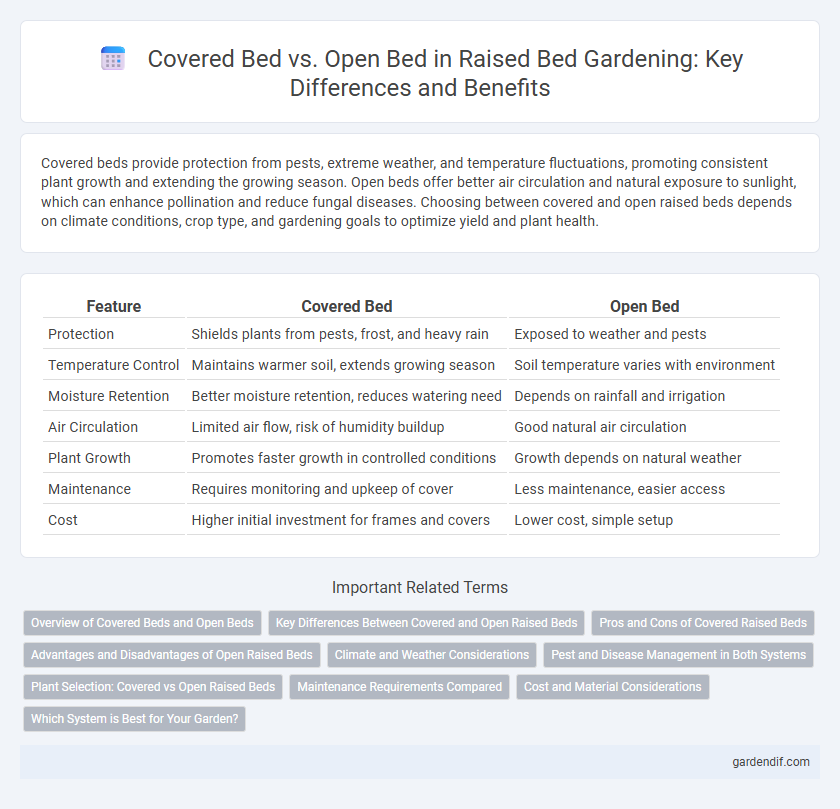
Covered bed vs Open bed Illustration
Covered beds provide protection from pests, extreme weather, and temperature fluctuations, promoting consistent plant growth and extending the growing season. Open beds offer better air circulation and natural exposure to sunlight, which can enhance pollination and reduce fungal diseases. Choosing between covered and open raised beds depends on climate conditions, crop type, and gardening goals to optimize yield and plant health.
Table of Comparison
| Feature | Covered Bed | Open Bed |
|---|---|---|
| Protection | Shields plants from pests, frost, and heavy rain | Exposed to weather and pests |
| Temperature Control | Maintains warmer soil, extends growing season | Soil temperature varies with environment |
| Moisture Retention | Better moisture retention, reduces watering need | Depends on rainfall and irrigation |
| Air Circulation | Limited air flow, risk of humidity buildup | Good natural air circulation |
| Plant Growth | Promotes faster growth in controlled conditions | Growth depends on natural weather |
| Maintenance | Requires monitoring and upkeep of cover | Less maintenance, easier access |
| Cost | Higher initial investment for frames and covers | Lower cost, simple setup |
Overview of Covered Beds and Open Beds
Covered beds provide protection from pests, weather fluctuations, and soil erosion, enhancing plant growth by creating a controlled microenvironment. Open beds offer unrestricted exposure to natural elements, supporting robust root development and beneficial microbial activity in the soil. Choosing between covered and open beds depends on factors such as crop type, climate conditions, and pest management priorities.
Key Differences Between Covered and Open Raised Beds
Covered raised beds provide protection from pests, extreme weather, and soil erosion, enhancing plant growth by maintaining consistent moisture and temperature levels. Open raised beds offer better air circulation, easier access for maintenance, and are often preferred for crops requiring more sunlight and airflow. The choice between covered and open beds depends on climate, crop type, and gardening goals, impacting yield and garden management.
Pros and Cons of Covered Raised Beds
Covered raised beds provide protection against pests, extreme weather, and soil erosion, creating a controlled microclimate that enhances plant growth and extends the growing season. They require more initial investment and maintenance, including monitoring for proper ventilation to prevent mold and overheating. While open beds offer ease of access and natural pollination, covered beds excel in safeguarding plants and improving yield consistency in challenging environments.
Advantages and Disadvantages of Open Raised Beds
Open raised beds offer excellent air circulation and direct sunlight exposure, promoting healthy plant growth and reducing mold risk. Their accessibility and ease of construction make them a popular choice for gardeners, but they lack protection from pests, harsh weather, and soil erosion compared to covered beds. Soil moisture can fluctuate more in open beds, requiring more frequent watering and monitoring.
Climate and Weather Considerations
Covered raised beds provide superior protection against extreme weather conditions such as frost, heavy rain, and strong winds, creating a controlled microclimate that promotes year-round plant growth. Open raised beds rely on natural weather patterns and offer better air circulation, reducing the risk of fungal diseases but exposing plants to temperature fluctuations and potential drought stress. Selecting between covered and open beds depends on regional climate challenges, with covered beds ideal for colder, wetter areas and open beds suited for mild, stable environments.
Pest and Disease Management in Both Systems
Covered raised beds offer enhanced protection against pests and diseases by creating a physical barrier that reduces insect intrusion and limits airborne pathogens, leading to fewer infestations and lower disease incidence. Open raised beds, while more exposed to natural pest predators and beneficial insects, require vigilant monitoring and integrated pest management practices to control outbreaks effectively. Both systems demand tailored strategies; covered beds benefit from controlled environments that minimize chemical interventions, whereas open beds rely more on biological controls and crop rotation to maintain plant health.
Plant Selection: Covered vs Open Raised Beds
Covered raised beds allow for a wider variety of plant selection by offering protection from pests, extreme weather, and temperature fluctuations, which supports the growth of delicate or heat-loving crops such as tomatoes, peppers, and herbs. Open raised beds are ideal for plants that require more airflow and direct sunlight, such as root vegetables and leafy greens, benefiting from natural pollination and less humidity buildup. Selecting between covered and open raised beds depends on crop-specific needs, microclimate considerations, and pest control preferences to maximize plant health and yield.
Maintenance Requirements Compared
Covered raised beds require less frequent weeding and protect plants from pests and extreme weather, significantly reducing maintenance time compared to open beds. Open raised beds demand more consistent monitoring for soil erosion, pest control, and nutrient replenishment, increasing overall labor. Choosing covered beds optimizes garden upkeep by minimizing interventions and preserving soil health effectively.
Cost and Material Considerations
Covered beds typically require materials such as polycarbonate panels or greenhouse plastic, which increase initial costs but provide insulation and protection from pests, extending plant life. Open beds use readily available materials like untreated wood or metal, offering lower upfront expenses but less control over environmental factors. Budget constraints often influence the choice, with covered beds demanding higher investment in durable materials versus the cost-effectiveness of open bed setups.
Which System is Best for Your Garden?
Covered beds offer superior protection against pests, extreme weather, and soil erosion, making them ideal for delicate plants or regions with unpredictable climates. Open beds provide better airflow and natural pollination, supporting robust root development and a wider variety of crops. Choosing the best system depends on your garden's environmental conditions, plant types, and maintenance preferences.
Covered bed vs Open bed Infographic

 gardendif.com
gardendif.com